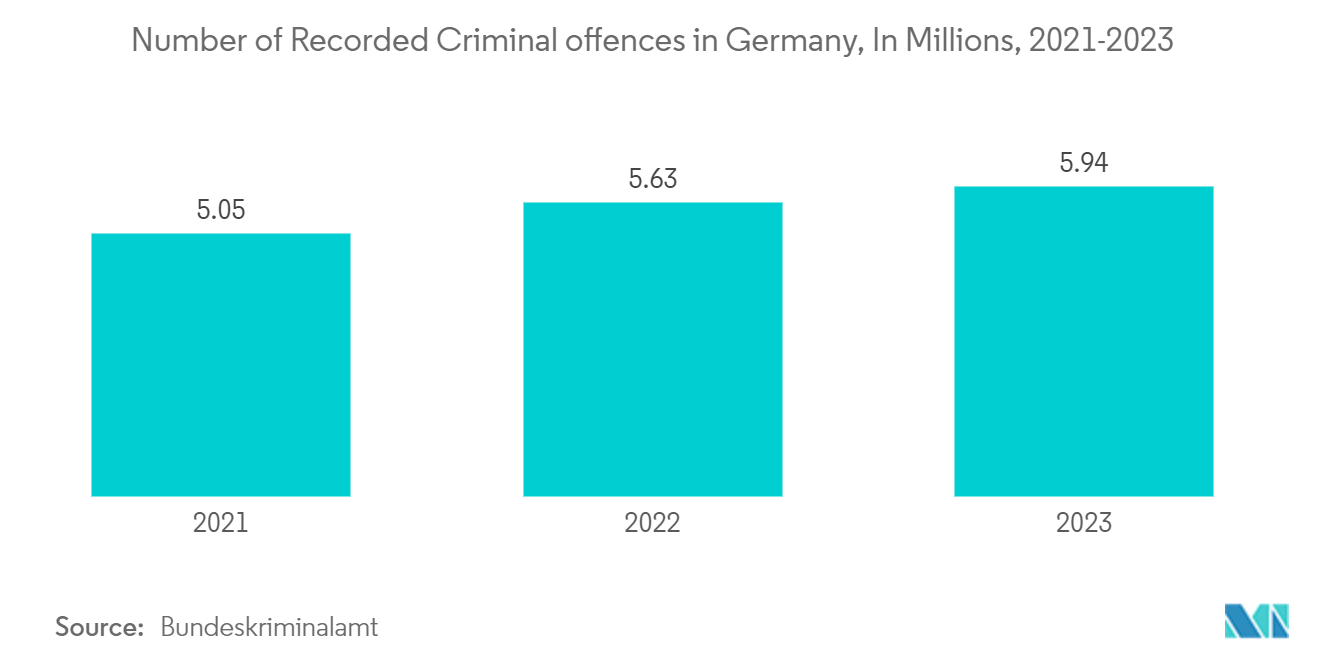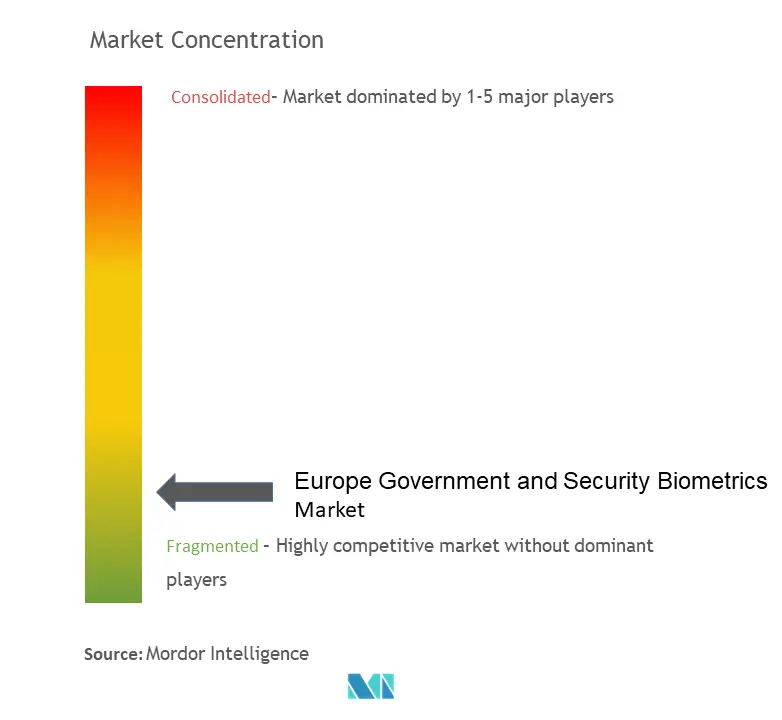Europe Government And Security Biometrics Market Size and Share

Europe Government And Security Biometrics Market Analysis by Mordor Intelligence
The Europe Government And Security Biometrics Market size is estimated at USD 5.71 billion in 2025, and is expected to reach USD 11.69 billion by 2030, at a CAGR of 15.4% during the forecast period (2025-2030).
Biometric security solutions and analytics technologies provide government agencies with unprecedented real-time data identification and verification capabilities, improving security and data understanding. The biometric identification market for government and security purposes is expected to register significant growth due to the increasing security requirements, as well as the growing theft of sensitive data and information.
- Security biometrics have many uses, particularly in digital privacy and security. The development of biometric technology has enabled it to become more accurate, reliable, and easy to integrate, leading to increased utilization of biometrics solutions. The European Union’s new law directive entered force in June 2023 to eliminate discrepancies and consolidate existing regulations. Prum Regulation enables law enforcement agencies to exchange information, including facial biometric data, to facilitate cross-border searches for criminals and suspects.
- Using biometric systems is becoming increasingly prevalent to guarantee a secure and equitable electoral process. These systems provide identification solutions for registration, voting, counting, and identification. Standard identification methods include fingerprint, palm vein, iris, and facial recognition. The UK government announced that its residents would have to present photographic identification when voting in certain elections starting in May 2023 due to the passage of the Elections Act in April 2022. The new rules will require the support of a variety of documents, including passports, driving licenses, biometric immigration IDs, and specific electoral identity cards.
- The growth of the biometrics market is primarily attributed to the increasing use of morphological identifiers (iris, palm vein, fingerprint, and facial recognition scanners), increasing government expenditure on security improvements, and stringent government regulations and modernized identification procedures for voter equality. Additionally, in the face of document fraud, identity theft, terrorism, cybercrime, and changes in regional regulations, new biometrics security solutions are being deployed. The demand for iris recognition is rising due to its distinctive and precise identification capabilities focusing on security and efficiency.
- The potential repercussions of a biometric data breach can be dire, as individuals may be exposed to the risk of fraudulent activities and identity theft, mainly if the information is not adequately safeguarded, thus impeding the development of the market. Furthermore, as with any technology, the biometric systems may be subject to malicious interference, such as spoofing, manipulation, or hacking, which can compromise their effectiveness.
- In May 2023, Europe implemented a regulation prohibiting the implementation of mass facial recognition programs in public spaces and the use of predictive policing algorithms that attempt to identify future criminals using personal data. Additionally, the regulation requires establishing a publicly available database of high-risk artificial intelligence (AI) systems employed by public and government entities to provide European citizens with information on when and how this technology is impacting them.
Europe Government And Security Biometrics Market Trends and Insights
Facial Recognition to Hold Significant Market Share
- Facial recognition technology offers robust security measures by accurately distinguishing individuals based on their unique facial features, preventing unauthorized access to facilities, devices, or data. Government agencies utilize facial recognition to regulate access to secure premises or systems.
- For instance, in June 2023, the French government approved a law allowing the testing of facial recognition in public areas for three years. This law permits judicial examiners and intelligence agencies to use remote biometric identifiers in public places, with real-time application restricted to detecting terrorists, child abductions, and severe criminal offenses. Retrospective facial recognition applications on recorded videos require authorization from the prosecutor or examining judge for terrorism and serious crime investigations.
- In April 2023, the Swiss government allocated USD 27.18 million to upgrade the automated fingerprint matching system (AFIS) with biometric fingerprint recognition. AFIS has long been used by law enforcement authorities and governments for criminal investigations in electoral and migration processes. Swiss police state that AFIS processes over 340,000 identity applications annually from domestic and foreign law enforcement, customs, and migration authorities.
- Integration of facial recognition systems with surveillance cameras enables real-time identification of individuals in public areas, aiding law enforcement in monitoring and responding to potential criminal activity. In 2023, Germany registered 5.94 million crimes, necessitating effective methods for quick suspect identification. Facial recognition facilitates rapid identification by matching suspect images with databases of known criminals.
- Biometrics, including facial recognition, are increasingly adopted at airports to enhance operational efficiency. For instance, Germany announced in February 2024 that it would exclusively accept biometric photographs for official documents, streamlining the identification and verification process. Additionally, in May 2024, British travelers underwent new entry procedures into the European Union as part of the entry/exit system (EES), requiring facial photography and fingerprint scanning alongside passport checks.

United Kingdom to Witness Significant Growth
- Facial recognition technology serves as a powerful tool for law enforcement agencies, swiftly identifying individuals and cross-referencing them with criminal databases to investigate and prevent illegal activities. Its surveillance capabilities act as a deterrent, dissuading potential offenders. Moreover, it fosters collaboration among law enforcement agencies across jurisdictions, aiding in tracing criminal activities involving international travel.
- The United Kingdom planned to reintroduce facial recognition technology following a report revealing enhanced accuracy and reduced false positives in April 2023. The technology's consistent performance across racial and gender groups, with a false match rate of just 1 out of 6,000 individuals passing through the camera, underscores its reliability. Set at a default threshold of 0.6, Neoface achieves correct identification 89% of the time with a mere 0.017% false positive rate, as per the National Physical Laboratory.
- The demand for secure identity verification, particularly driven by clearance visas, fuels the need for stringent biometric procedures. With approximately 3.06 million entry clearance visas issued by the UK government in March 2023, biometric technologies offer a reliable means of ensuring visa holders' identity, reducing fraudulent access risks.
- In 2024, the United Kingdom will pilot a new face biometrics system for passport-free border checks at air and rail ports, aiming to streamline traveler entry processes. This initiative, reported by The Times, seeks to enhance user experience and efficiency, potentially replacing 270 gates over time as legacy passport desks are phased out.
- Biometric adoption in the United Kingdom is on the rise, fostering innovation and ecosystem growth. A 2023 survey by law firm Womble Bond Dickinson found that six out of 10 UK companies integrate biometrics into their operations. Among the 205 executives surveyed, 59% utilize biometrics, with only 20% having no plans for adoption. Fingerprint, facial recognition, voice recognition, iris scans, and ear data are among the biometric data types collected, with varying degrees of usage.

Competitive Landscape
The European government and security biometrics market is fragmented and characterized by numerous players in the market. Significant players are adopting strategies like new product launches, mergers and acquisitions, partnerships, product innovation, and collaborations. Some of the key players in the market include id3 Technologies, IrisGuard Ltd, BioID, Innovatrics, DERMALOG Identification Systems GmbH, Veridos GmbH, BIO-key International Fulcrum Biometrics, Corsight AI, IDEMIA, Fujitsu, NEC Corporation, and Thales Group.
- March 2024: The European Union's highest court made a ruling stating that governments requiring the submission of fingerprint biometrics for identity cards are not in violation of European privacy laws. The European Court of Justice has explained that the compulsory collection of fingerprint data on ID cards aligns with fundamental privacy rights. The court further argues that obtaining biometrics is justified in combating identity theft and ensuring the compatibility of verification systems.
- January 2024: Thales finalized the acquisition of Imperva, solidifying its position as a global cybersecurity leader. Thales aims to fortify organizations' data protection and access management capabilities worldwide. With North America now serving as Thales' second-largest operational hub, the acquisition marks the company's ninth investment in digital security within the past nine years. Ranked as the second-largest acquisition in Thales' history following Gemalto, Imperva's incorporation strengthens Thales to advance cybersecurity solutions on a global scale.
Europe Government And Security Biometrics Industry Leaders
-
Veridos GmbH
-
IrisGuard Ltd
-
Corsight AI
-
Innovatrics
-
DERMALOG Identification Systems GmbH
- *Disclaimer: Major Players sorted in no particular order

Recent Industry Developments
- May 2024: UK travelers faced new entry procedures to the European Union, known as the entry/exit system (EES), an automated IT system that replaces traditional passport-stamping methods. Effective autumn 2024, travelers must undergo facial photography and fingerprint scanning alongside passport checks. The EES aims to streamline data collection, enhancing border security and efficiency. This shift signifies a global move towards stricter border monitoring and security.
- February 2024: Beginning in May 2025, German authorities will exclusively accept biometric photographs for official documents. According to the German Ministry of Interior, this transition aims to bolster document security, streamline identification processes, and mitigate inconveniences during border controls. Biometric data capture will combat photo manipulation techniques like facial morphing, first identified by the German Federal Police in 2013.
Europe Government And Security Biometrics Market Report Scope
Security biometrics is a form of biometrics that, at the most fundamental level, involves measuring biological features such as fingerprints, iris patterns, eye retinal, and other identifiers. This data is then used to create a unique biometric signature that can only be attributed to a single individual. Companies are now beginning to recognize the advantages of biometrics, as they are now being used for various purposes.
The European government and security biometrics market is segmented by type (iris recognition, voice recognition, face recognition, palm print recognition, and fingerprint recognition), application (border safety and immigration, e-passport, national ID, e-visas, voter identification, access control and physical security, mobile identification, authentication/verification, and public services), and country. The market sizes and forecasts are provided in terms of value (USD) for all the above segments.
| Iris Recognition |
| Voice Recognition |
| Face Recognition |
| Palm Print Recognition |
| Fingerprint Recognition |
| Border Safety and Immigration |
| E-Passport |
| National ID |
| E-Visas |
| Voter Identification |
| Access Control and Physical Security |
| Mobile Identification |
| Authentication/Verification |
| Public Services |
| United Kingdom |
| Germany |
| France |
| Spain |
| Italy |
| Norway |
| Sweden |
| By Type | Iris Recognition |
| Voice Recognition | |
| Face Recognition | |
| Palm Print Recognition | |
| Fingerprint Recognition | |
| By Application | Border Safety and Immigration |
| E-Passport | |
| National ID | |
| E-Visas | |
| Voter Identification | |
| Access Control and Physical Security | |
| Mobile Identification | |
| Authentication/Verification | |
| Public Services | |
| By Country | United Kingdom |
| Germany | |
| France | |
| Spain | |
| Italy | |
| Norway | |
| Sweden |
Key Questions Answered in the Report
How big is the Europe Government And Security Biometrics Market?
The Europe Government And Security Biometrics Market size is expected to reach USD 5.71 billion in 2025 and grow at a CAGR of 15.40% to reach USD 11.69 billion by 2030.
What is the current Europe Government And Security Biometrics Market size?
In 2025, the Europe Government And Security Biometrics Market size is expected to reach USD 5.71 billion.
Who are the key players in Europe Government And Security Biometrics Market?
Veridos GmbH, IrisGuard Ltd, Corsight AI, Innovatrics and DERMALOG Identification Systems GmbH are the major companies operating in the Europe Government And Security Biometrics Market.
Which is the fastest growing region in Europe Government And Security Biometrics Market?
Europe is estimated to grow at the highest CAGR over the forecast period (2025-2030).
Which region has the biggest share in Europe Government And Security Biometrics Market?
In 2025, the Europe accounts for the largest market share in Europe Government And Security Biometrics Market.
What years does this Europe Government And Security Biometrics Market cover, and what was the market size in 2024?
In 2024, the Europe Government And Security Biometrics Market size was estimated at USD 4.83 billion. The report covers the Europe Government And Security Biometrics Market historical market size for years: 2019, 2020, 2021, 2022, 2023 and 2024. The report also forecasts the Europe Government And Security Biometrics Market size for years: 2025, 2026, 2027, 2028, 2029 and 2030.
Page last updated on:
Europe Government And Security Biometrics Market Report
Statistics for the 2025 Europe Government And Security Biometrics market share, size and revenue growth rate, created by Mordor Intelligence™ Industry Reports. Europe Government And Security Biometrics analysis includes a market forecast outlook for 2025 to 2030 and historical overview. Get a sample of this industry analysis as a free report PDF download.



